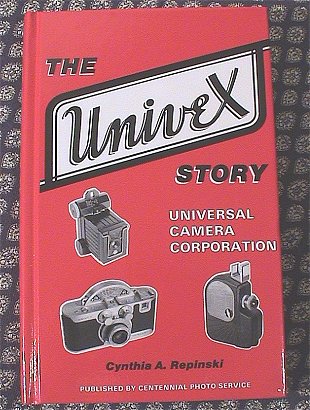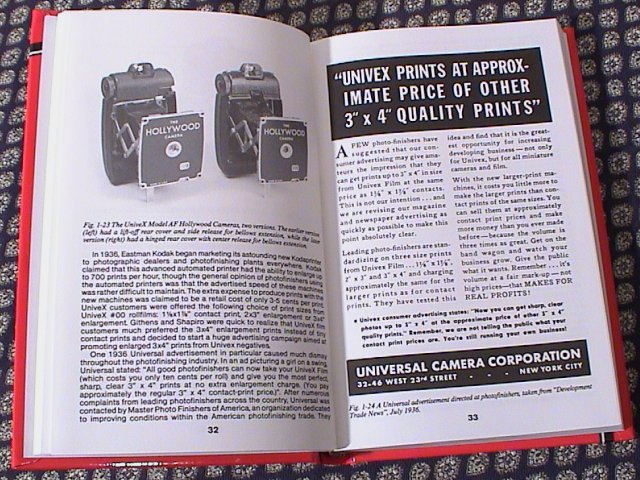 The Univex Story is more impressive than similar books
about the Rollei and some of those on the Minox. The proportional spaced
text with right justification and bold font makes reading harder and there
are 272 pages to read through. Interest for subminiature collectors starts
on Page 9 to 34, about the model A and AF cameras and then skipping to 209
to pick up on the minute 16. The Univex Story is more impressive than similar books
about the Rollei and some of those on the Minox. The proportional spaced
text with right justification and bold font makes reading harder and there
are 272 pages to read through. Interest for subminiature collectors starts
on Page 9 to 34, about the model A and AF cameras and then skipping to 209
to pick up on the minute 16.
Universal Camera Company was really a very interesting outfit. It was started in NYC by a guy who made his living financing used car sales for small dealers. The company started making cameras in about 1932. Their first camera was called a Univex, a name that would appear on many of its products. The camera was made of GE "Texolite" plastic which was very much like Bakelite, and had a crude wire frame view finder which folded down along the side of the camera body Single speed shutter. Miniscus lens. In 1932 the camera sold for 39 cents, which was a significant chunk of change during the depression days. In 1934 Universal sold over 2.6 million of these little pocket cameras. Production rates went up to 20 thousand cameras per day during the rather extended production life of this camera.. The first Univex used size 00 film which was excusive to Universal Camera Co. The frame as 28mm wide and 38mm (1 1/8 inch x 1 1/2 inch) "portrait" orientation like 35mm half-frame cameras. Size 00 film was a significant battle for Kodak's emerging 35mm business. No other film maker produced 00 film, so Universal had a monopoly. The Univex A cameras were made by Norton Laboratories who had a difference of opinion consequently Norton marketed the camera which they designed for Universal under their own name. The Norton camera never sold well and the Universal won. Besides the A model there were folding cameras using the same 00 film format. e.g. AF to AF-5. Following the success of the Univex 00 camera, Universal produced inexpensive single 8mm movie cameras and projectors. A 30 ft roll of single 8mm B&W Univex film cost 60 cents. Universal's last gasp was the Mercury II 35mm half-frame camera with a rotating shutter that was often referred to as the "guillotine" whirling shutter. Actually, the shutter was not a spinning disk, but consisted of two semi-circular shutter blades that swung open and shut in a circular motion. Pacific Coast Merchandise company made a simple wire frame allowing two Univex A cameras to be attached for stereo. In the early 1950s Universal invested heavily in the Minute 16 (over $2,000,000 in research and development). The Minute 16 feels heavy in the hand, solid, but had film advance problems and the f6.3 lens was terrible. From report by Roland F. Harriston, and additional notes by Douglas St. Denny and Gerald McMullon |
|
Ebay |
 |